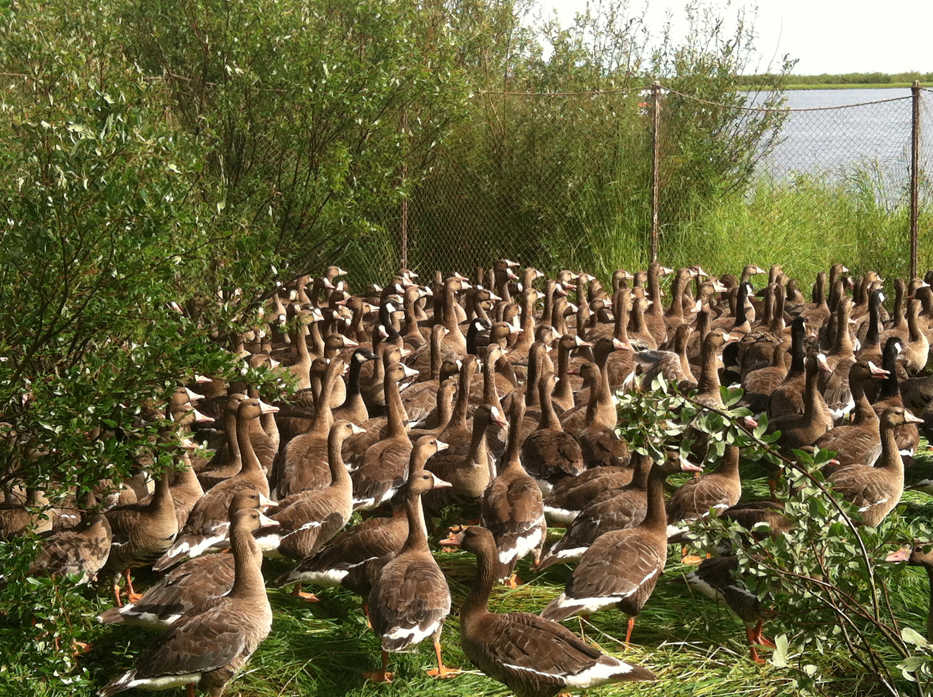That’s right! National Wildlife Refuges like to do things in style. And by style I mean using float planes to herd geese in order to place bands on them.
The banding of Greater White Fronted Geese has been an annual effort at Innoko National Wildlife Refuge in interior Alaska since 1985, with the exception of three years in the 1990s. As a biological intern at the Kenai National Wildlife Refuge, I was loaned out to be part of this efficient and experienced field crew.
The operation focuses on failed or nonbreeding geese that become flightless as they molt on the Innoko River. This river attracts molt migrants (geese from other breeding areas) because of the abundance of vital foraging habitat, and it is here the geese initiate their molt early. Successful breeders, on the other hand, remain with their broods and molt later in the season.
Greater White Fronted Geese typically live up to 20 years in the wild and have the potential to mate every year. As with all waterfowl, there is always a proportion of the population that doesn’t breed. Geese cannot successfully breed if they are less than three years old or if their nutrition is inadequate. Predation of eggs or young by coyotes, fox, wolves, eagles, and even great horned owls is also a problem for obvious reasons.
Goose banding entails capturing them and placing an aluminum ring around their leg with a unique number engraved into it. Looking somewhat like a really flashy ankle bracelet, bands are used to document proportional harvest, breeding areas, and annual survival of adults. Annual survival is determined from harvest reports by subsistence and sport hunters, as well as from recaptured individuals during subsequent banding efforts.
Lead by Julian Fischer from the USFWS Division of Migratory Birds in Anchorage, this operation begins with a scout plane. A pilot flies out and picks a group of geese to band. Ideally, it’ll be a flock of no more than 350 geese, and one that can be reached by plane and is well positioned for herding.
Once a flock is chosen, the crew is transported in five floatplanes (two Cessna 206s, Super Cub, Top Cub, and Cessna 185) to the designated trapping spot. The 11 of us create a V-shaped trap with mist nets. One end of the “V” is longer and is called the “long lead” because this is the direction the geese will be entering; the short end is the “short lead”. Where the two leads meet at the base of the “V” is a circle called “the pot.” The pot is where the geese are temporarily held while a few individuals are banded and released.
After the nets are set, the planes herd the flock towards the trap. With one plane coordinating high overhead from a bird’s-eye-view, the other four planes can be directed either in the air or on the water.
The whole operation becomes a well-executed kidnapping mission. Two crew members remain to take position on the short and long lead ends of the net. I was on the long lead end where I hid behind bushes, ready to hop out in case the geese sought to run around the nets. I carried five essentials with me: a hand-held radio, shotgun, bear spray, bug jacket and, of course, beef jerky.
While waiting in the shrubbery, I sat and listened to the operation over the radio. My excitement grew with the increasing roar of the planes’ engines and honking of geese. Final commands were given and I watched as the confused flock of geese walked smoothly from water to shore and into the pot.
The banding itself is an assembly line. Geese are captured in the pot and handed over the ropes to a carrier. The carrier transports them to people kneeling on a tarp with pliers and bands. The sex of the goose is determined by inverting the cloaca. Substantial black coloration on the lower chest indicates that the goose is older than two years. These observations, along with the band number, are verbalized to the recorder. Lastly, the geese are released back into the water.
This year, the U.S. Fish and Wildlife Service crew banded more geese than during any of the previous 29 years of this program — 1,200 geese after two days! The yearly goal is 1,000 and the pot sizes are kept small to reduce stress on the geese. Fortunately, no geese fatalities occurred.
A successful operation with more geese banded. These efforts are essential for monitoring and protecting another one of Alaska’s magnificent creatures.
Brianna Kilbourne is a biological intern at the Kenai National Wildlife Refuge. You can find more information about the refuge at http://kenai.fws.gov or http://www.facebook.com/kenainationalwildliferefuge.

